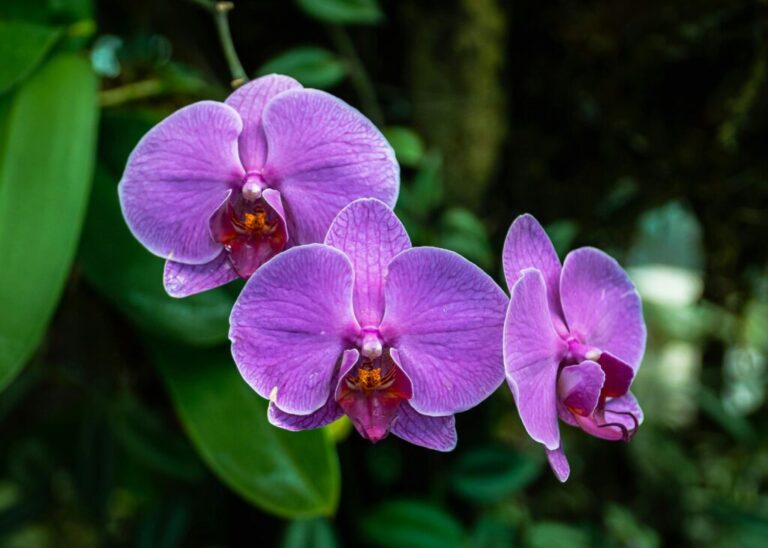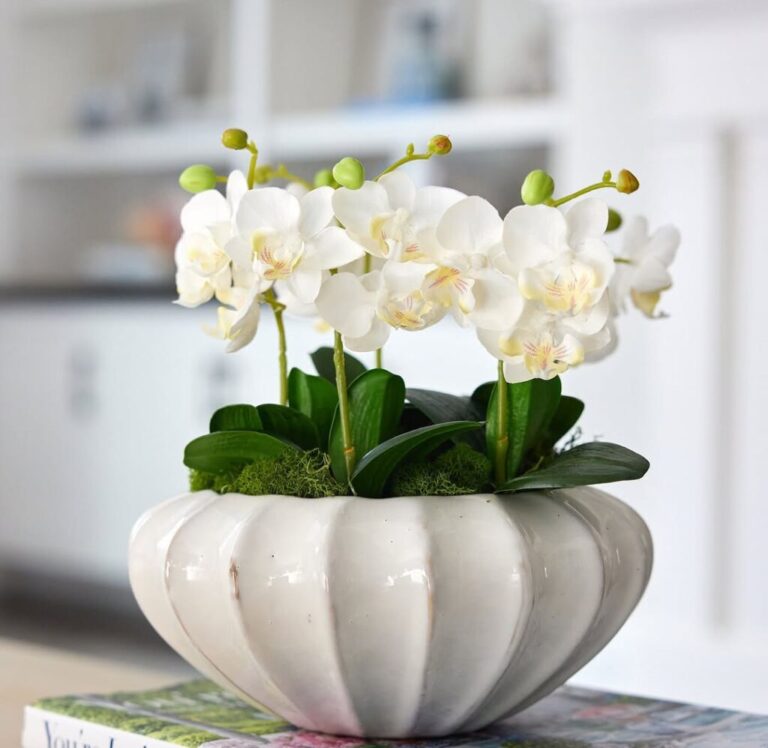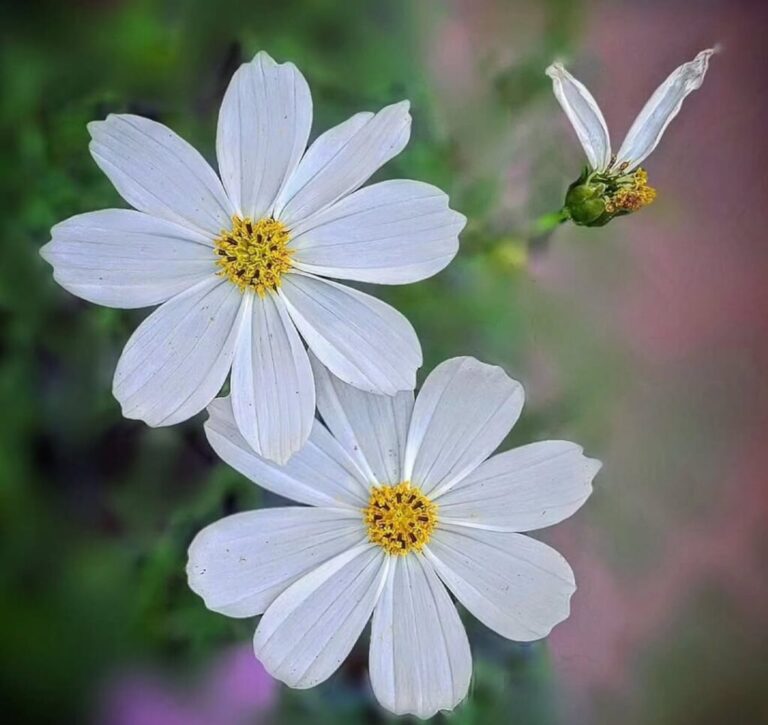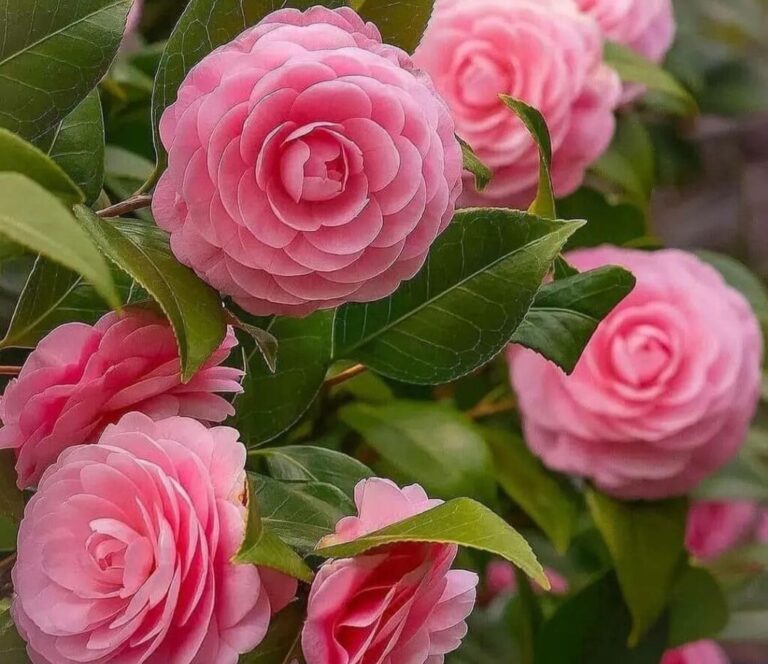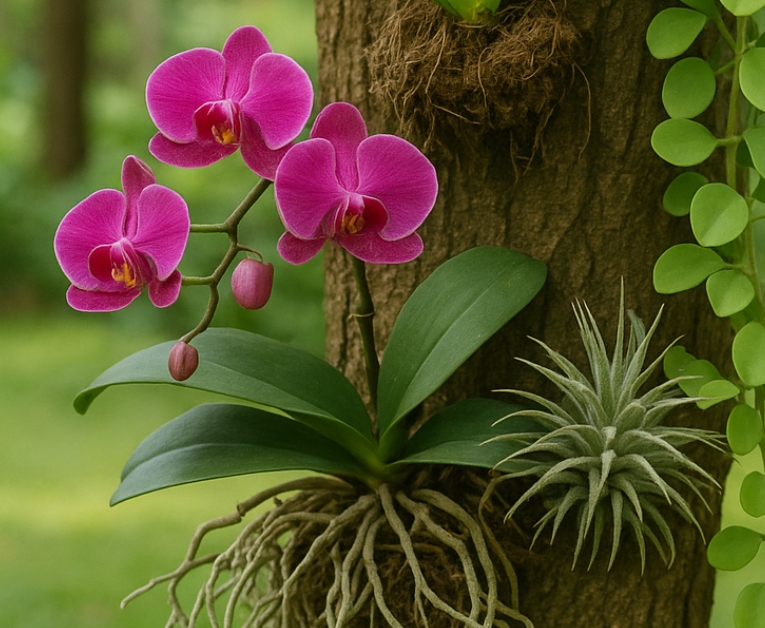- 1 Optimal Temperature Control:
- 2 Proper Lighting:
- 3 Humidity Management:
- 4 Watering Wisely:
- 5 Selecting the Right Potting Mix:
- 6 Avoid Drafts:
- 7 Winter Fertilisation:
- 8 Isolate sick orchids:
- 9 Regular Inspection:
- 10 Protect from drastic temperature drops:
- 11 Consider a Winter Rest:
- 12 Avoid Cold Windowsills:
- 13 Trim yellowing leaves:
- 14 Gentle repotting if necessary:
- 15 Patience and observation:
- 16 Proper Ventilation:
- 17 FAQ
16 best expert tips to keep orchids alive in winter
As winter blankets the world in a frosty embrace, orchid enthusiasts may find themselves facing unique challenges in keeping these delicate and exotic flowers alive. Fear not, as we’ve gathered insights from expert orchid enthusiasts to guide you through the winter months with confidence. Here are 16 valuable tips to help your orchids not only survive but thrive during the colder season.
Optimal Temperature Control:
Maintaining optimal temperature control is crucial for the well-being of orchids. Aim for a consistent temperature range of 60–75°F (15–24°C) during the day and slightly cooler temperatures at night. This mimics their natural habitat and supports healthy growth. Fluctuations outside this range can stress orchids, impacting their overall health and blooming patterns. Utilise heating or insulation measures as needed to create a stable and comfortable environment for your orchids.

Proper Lighting:
Providing proper lighting is essential for the thriving of orchids. Place them near a south-facing window to ensure they receive filtered sunlight, which is optimal for their growth. If natural light is insufficient, supplement with artificial lights, such as fluorescent or LED grow lights. Striking the right balance between light and shade is crucial for preventing sunburn while promoting photosynthesis. Regularly assess the lighting conditions and adjust placement accordingly to maintain an environment that supports the orchids’ light requirements.
Humidity Management:
Effective humidity management is key to ensuring the well-being of orchids, especially during the winter months. Orchids thrive in high-humidity environments similar to their native habitats. To create an ideal setting:
Humidifier Usage:
Employ a humidifier to maintain a consistent humidity level. This is particularly beneficial in areas with dry winter air.
Water Trays:
Place water-filled trays or pebble trays near your orchids. The immediate humidity surrounding the plants rises as the water evaporation process continues.
Grouping Orchids:
Grouping orchids together can create a microclimate with elevated humidity. The collective transpiration of the plants contributes to a more favourable moisture level.
Misting:
Occasional misting can be beneficial, but ensure it doesn’t lead to waterlogged potting mix. Mist in the morning to allow sufficient drying time during the day.
Avoid Drafts:
Protect orchids from cold drafts, as they can contribute to rapid moisture loss. Drafts can negate your efforts to maintain a humid environment.
By implementing these strategies, you’ll provide your orchids with the optimal humidity conditions they need to flourish, even in the drier winter season.

Watering Wisely:
Watering orchids wisely is crucial, especially during the winter months. Follow these tips to ensure proper hydration without risking overwatering:
Keep an eye on soil moisture. Continuously assess the potting mix’s moisture content. Orchids generally require less water in winter, so allow the top inch of the mix to dry out before considering watering.
Use well-draining pots.
Plant orchids in pots with excellent drainage. This prevents water from accumulating around the roots, reducing the risk of root rot—a common issue in orchids.
Adjust Frequency:
Be mindful of the reduced water needs in the winter. Adjust your watering frequency accordingly, giving the orchids the opportunity for a slightly drier period between waterings.
Watering Technique:
Water the orchids thoroughly, allowing water to drain freely from the bottom of the pot. Ensure that excess water doesn’t linger in the pot’s saucer, as this can lead to root problems.
Think About the Type of Orchid: Water needs can differ throughout orchid species. Understand the specific needs of your orchid and tailor your watering routine accordingly.
By adopting a thoughtful and adaptive approach to watering, you’ll promote the health of your orchids and minimise the risk of water-related issues during the winter season.
Selecting the Right Potting Mix:
Choosing the right potting mix is fundamental for the well-being of orchids, particularly during the winter. Follow these guidelines to ensure an optimal growing medium:
Well-Draining Mix:
Opt for a well-draining orchid mix that allows for proper aeration. Orchids prefer a mix that replicates their natural epiphytic or lithophytic conditions, preventing waterlogged roots.
Bark-Based Mixes:
Many orchids thrive in bark-based mixes, which provide a balance of moisture retention and aeration. These mixes are commonly available and cater to the specific needs of orchids.
Avoid regular potting soil.
Steer clear of standard potting soil, as it retains too much water for orchids. Orchids are adapted to environments where their roots can breathe freely.
Consider the orchid type:
Different orchid species may have specific preferences. Research the type of orchid you have to determine the most suitable potting mix for its unique requirements.
Repot as Needed:
Monitor the condition of the potting mix and repot orchids when necessary. Over time, the mix may break down, impacting drainage and aeration.
By selecting a well-suited potting mix and periodically refreshing it, you provide your orchids with the essential foundation for healthy growth, especially during the winter season.
Avoid Drafts:
Protecting orchids from drafts is crucial for their well-being, especially in winter. Here’s why and how to avoid drafts:
Temperature Fluctuations:
Drafts can lead to sudden temperature changes, stressing orchids that thrive in stable conditions. Ensure a consistent temperature range to support their health.
Strategic Placement:
Position orchids away from windows, doors, or vents where drafts are common. Shielding them from direct exposure to chilly air helps maintain a more stable environment.
Use curtains or screens.
Employ curtains or screens to create a barrier between orchids and draughty windows. This provides insulation without blocking essential light.
Seal Gaps:
Check for gaps around windows and doors, sealing any openings that may allow drafts. This not only benefits orchids but also contributes to overall energy efficiency.
Protective Barriers:
If orchids are placed on windowsills, use insulating materials beneath the pots to shield them from the cold surface. This extra layer provides protection against temperature extremes.
By implementing these measures, you safeguard your orchids from the adverse effects of drafts, creating a more stable and comfortable environment for their winter care.
Winter Fertilisation:
Adjusting your fertilisation routine in the winter is crucial to supporting the natural growth patterns of orchids. Here’s how to approach winter fertilisation:
Reduced Frequency:
In the winter, orchids typically experience a slower growth rate. Reduce the frequency of fertilisation compared to the growing season. This acknowledges their dormancy or slowed metabolic state.
Balanced, Diluted Fertiliser:
Use a balanced orchid fertiliser with equal proportions of nitrogen, phosphorus, and potassium. Dilute the fertiliser to half or quarter strength to avoid overfeeding, as orchids require less nutrients during the winter months.
Monitor plant needs:
Pay attention to your orchids’ condition and adjust fertilisation based on their individual needs. If growth is minimal, scale back on fertiliser applications.
Application Method:
Apply fertiliser when the orchids are actively growing, typically during the warmer parts of the day. Avoid fertilising newly repotted orchids until they have settled into their new environment.
Pause in Rest Periods:
Some orchids, like Phalaenopsis, may enter a natural rest period in the winter. During this time, consider pausing fertilisation or providing a very diluted solution to support their minimal nutritional requirements.
Adapting your fertilisation practices in winter ensures that your orchids receive the appropriate nutrients without overwhelming them during their dormant or slower-growth phases.
Isolate sick orchids:
Isolating sick orchids is a proactive measure to prevent the spread of diseases among your orchid collection. Here’s why and how to do it:
Prevent Contamination:
Isolating sick orchids helps contain potential diseases, preventing them from spreading to healthy plants. This separation reduces the risk of an entire collection being affected.
Quarantine Area:
Designate a specific quarantine area for sick orchids. Keep them away from healthy plants to minimise the chance of airborne or waterborne pathogens reaching unaffected specimens.
Regular Inspection:
Conduct regular inspections of your orchids. If you notice any signs of disease, such as discoloration, unusual spots, or wilting, promptly move the affected orchid to the quarantine area.
Treatment in Isolation:
Treat the sick orchid in isolation to prevent the disease from spreading. Follow recommended treatment protocols, whether it involves pruning affected parts, applying fungicides, or addressing specific issues.
Observation Period:
Keep the isolated orchid under observation for an appropriate period. Ensure that it shows signs of recovery and is free from any contagious symptoms before reintroducing it to the main collection.
By practicing orchid quarantine, you can safeguard the health of your entire collection and address potential issues before they become widespread. Early detection and isolation are key components of effective orchid care.
Regular Inspection:
Regular inspection of your orchids is a fundamental practice to ensure their health and catch potential issues early. Here’s why and how to conduct regular inspections:
Avoid Overwatering:
Proper watering practices, such as allowing the top layer of potting mix to dry out before watering, contribute to better aeration in the root zone.
By prioritising proper ventilation, you create an environment that minimises the risk of diseases, supports optimal growth, and ensures the well-being of your orchids.
Protect from drastic temperature drops:
Shielding orchids from sudden temperature drops is crucial to prevent stress and potential damage. Here’s how to protect your orchids from drastic temperature changes:
Nighttime Window Placement:
If orchids are near windows, consider moving them away from windowsills during the night. Windowsills can become especially cold, exposing orchids to drastic temperature drops.
Use Insulating Materials:
Place insulating materials, such as foam or cardboard, between the orchids and cold windows. This additional layer helps buffer against temperature extremes.
Curtains or blinds:
Close curtains or blinds during the night to create an additional barrier against cold air. This helps maintain a more stable temperature around the orchids.
Temperature Monitoring:
Pay attention to weather forecasts, particularly in the winter. Be proactive in adjusting the orchids’ placement or implementing additional protective measures if a temperature drop is anticipated.
Heating Solutions:
Consider using portable heaters or heating mats in the vicinity of your orchids, especially if the room temperature tends to fluctuate significantly.
Covering at night:
If outdoor conditions are extremely cold, consider bringing potted orchids indoors for the night or covering them with a light blanket or frost cloth for protection.
By taking these precautions, you can help your orchids weather the winter nights more comfortably and avoid the negative impacts of sudden temperature drops.
Consider a Winter Rest:
Considering a winter rest is a thoughtful approach to orchid care, especially for certain species like Phalaenopsis. Here’s why and how to implement a winter rest:
Natural Dormancy:
Some orchids experience a natural dormancy or slowed growth period in the winter. Acknowledging this natural cycle allows the plant to conserve energy for future growth.
Reduced Watering:
During the rest period, adjust your watering routine to reflect the orchid’s slowed metabolic state. Allow the top layer of potting mix to dry out more thoroughly before watering.
Temperature Adjustment:
Orchids that benefit from a winter rest often appreciate a slight temperature drop. Adjust the environmental conditions to mimic the cooler temperatures they might experience in their native habitats.
Limit Fertilisation:
Reduce the frequency of fertilisation during the rest period. If you choose to fertilise, use a diluted, balanced fertiliser to support the orchid’s minimal nutritional needs.
Observe plant behaviour:
Pay close attention to your orchids’ behaviour during the winter months. If they exhibit signs of slowing growth, it may be an indication that they are naturally entering a rest phase.
Resume Normal Care in the Spring:
As winter transitions into spring, gradually resume your regular care routine. Increase watering, reintroduce fertilisation, and ensure optimal lighting conditions to support renewed growth.
By allowing your orchids a winter rest, you’re aligning your care practices with their natural cycles, promoting overall health and vitality. Always consider the specific requirements of the orchid species you have for the most effective care.
Avoid Cold Windowsills:
Preventing exposure to cold windowsills is crucial to safeguarding orchids from temperature extremes. Here’s how to avoid the negative impacts of cold windowsills:
Use Insulating Materials:
Place insulating materials, such as foam or cardboard, between the orchid pots and the cold windowsill. This provides a buffer against the chilly surface.
Move Orchids Inland:
If possible, position orchids away from windowsills, especially during colder nights. Choose a location within the room that is less susceptible to temperature fluctuations.
Consider window coverings:
Use curtains, blinds, or shades to create an additional layer of insulation. Closing window coverings during the night helps trap heat and prevents cold air from affecting the orchids.
Potted Orchids:
If orchids are in pots, place them on trays or mats to elevate them slightly above the windowsill. This minimises direct contact with the cold surface.
Temperature Monitoring:
Regularly monitor room temperatures, especially during colder weather. Adjust the placement of the orchids accordingly to avoid prolonged exposure to cold windowsills.
Indoor plant stands:
Consider using indoor plant stands to raise orchids above windowsills. This provides added insulation and ensures that the orchids are not directly affected by the cold surface.
By implementing these measures, you create a more controlled environment for your orchids, protecting them from the potentially harmful effects of cold windowsills during the winter months.
Trim yellowing leaves:
Trimming yellowing leaves is an essential part of orchid care, promoting overall plant health. Here’s how and why you should trim yellowing leaves:
Signs of stress or ageing:
Yellowing leaves in orchids can indicate stress, ageing, or nutrient deficiencies. Trimming these leaves helps redirect the plant’s energy to healthier parts.
Prevent the Spread of Disease:
Prompt removal of yellowing leaves minimises the risk of disease spreading. Infected or dying tissue can harbour pathogens, so trimming helps prevent further complications.
Sterilise Tools:
Before trimming, ensure your cutting tools are clean and sterilized. This reduces the likelihood of introducing infections to the orchid. Pay attention to weather forecasts, particularly in the winter.
Trim at Base:
Trim the yellowing leaves at the base where they connect to the stem. Make clean cuts to avoid unnecessary damage to the surrounding healthy tissue.
Regular Inspection:
Incorporate leaf inspection into your regular orchid care routine. Check for signs of yellowing, browning, or other anomalies, addressing them promptly.
Dispose Properly:
Dispose of trimmed leaves carefully to prevent the potential spread of pathogens. Place them in a sealed bag or container before discarding them.
By trimming yellowing leaves, you not only enhance the visual appeal of your orchid but also contribute to its overall vitality and resilience against potential health issues.
Gentle repotting if necessary:
Gentle repotting is a delicate process that can benefit orchids when necessary. Here’s how and why you might consider gentle repotting:
Assess root health:
Check the roots of your orchid for signs of overcrowding, decay, or rot. If the roots are unhealthy, it may be time for repotting.
Choose the right time:
Opt for repotting during the orchid’s active growth phase, typically after flowering. This allows the plant to recover more efficiently.
Select a well-draining mix:
Choose a well-draining orchid mix suitable for your specific orchid type. This ensures good aeration and prevents waterlogged roots.
Be Gentle:
During the repotting procedure, handle the orchid with caution. Gently remove it from its current pot, being mindful not to damage the roots or disturb the growth.
Inspect and trim roots:
Examine the roots for any indications of decay or illness. Trim away damaged or dead roots using sterile tools to promote healthy regrowth.
Place in a new container:
Repot the orchid into a clean container with fresh orchid mix. Ensure that the orchid sits at the same depth as before to avoid burying the pseudobulbs.
Watering After Repotting:
Water the orchid lightly after repotting, allowing the roots to settle into their new environment. Avoid overwatering during the initial days.
Monitor for stress:
Keep an eye on the orchid for signs of stress after repotting. Adjust care routines if needed and allow the plant time to acclimatise.
Gentle repotting, when done with care and consideration for the orchid’s well-being, can contribute to improved growth, better flowering, and overall plant health.
Patience and observation:
Practicing patience and observation is fundamental to successfully caring for orchids. Here’s why and how to cultivate these qualities:
Understanding Individual Needs:
Each orchid is unique, and patience allows you to understand its specific requirements. Observe its growth patterns, responses to care, and any signs of distress.
Adapting Care Routines:
Orchids may take time to adjust to changes in their environment. Patience is key when adapting care routines, allowing the plant to acclimatise gradually.
Seasonal Changes:
Orchids often exhibit seasonal variations in growth and flowering. Patiently observe these changes and adjust care accordingly, recognising the natural cycles.
Response to stress:
Orchids may show signs of stress, such as yellowing leaves or reduced flowering. Patience enables you to observe these signals and take corrective actions thoughtfully.
Avoiding Overcorrection:
If an orchid encounters challenges, resist the urge to make abrupt changes. Patiently observe the plant’s response before implementing adjustments to avoid overcorrection.
Recording Observations:
Maintain a log of your observations, noting changes in growth, flowering, and any issues encountered. This record becomes a valuable reference for refining your orchid care practices.
Celebrating Progress:
Patience allows you to appreciate the gradual progress of your orchids. Celebrate milestones such as new growth, healthy blooms, or successful acclimation.
Proper Ventilation:
Proper ventilation is crucial for maintaining a healthy environment for your orchids. This practice involves ensuring that there is adequate air circulation around the plants. Here’s why proper ventilation is important and how to achieve it:
Importance:
Preventing Stagnant Air: Adequate ventilation prevents the buildup of stagnant air around orchids, reducing the risk of fungal and bacterial issues. It promotes fresh air circulation, which is essential for plant respiration.
Temperature Regulation: Proper ventilation helps regulate temperatures. Orchids benefit from a stable and moderate environment, and good air movement contributes to temperature consistency.
Reducing Pest Risks: Well-ventilated spaces are less attractive to pests. Adequate airflow can deter common orchid pests, helping to maintain a healthier growing environment.
How to Achieve Proper Ventilation:
Strategic Placement: Position orchids in areas with good air movement. Avoid placing them in enclosed spaces where air can become stagnant.
Use Fans: Employ gentle fans to promote air circulation. Ensure the fans are set on low to avoid direct, strong drafts that might stress the orchids.
Open Windows and Doors: When weather conditions permit, open windows and doors to allow fresh air to circulate. This natural ventilation contributes to a healthier growing environment.
Spacing Between Orchids: Arrange orchids with enough spacing between them. This helps prevent overcrowding and allows each plant to receive adequate air circulation.
Avoid overwatering: Proper watering practices, such as allowing the top layer of potting mix to dry out before watering, contribute to better aeration in the root zone.
By prioritising proper ventilation, you create an environment that minimises the risk of diseases, supports optimal growth, and ensures the well-being of your orchids.
With these expert tips, you’re well-equipped to provide your orchids with the care they need to flourish throughout the winter months. Remember that each orchid is unique, so tailor your approach based on their specific requirements. By combining knowledge, care, and a touch of patience, you’ll be rewarded with vibrant and healthy orchids, even in the coldest of seasons.
FAQ
How do I adjust my orchid care routine during the winter according to expert tips?
Experts recommend reducing watering frequency, providing adequate light, and adjusting indoor temperatures to ensure your orchids thrive during the winter months
Can I keep my orchids near a window in winter, and what precautions should I take?
Yes, placing orchids near a window for sufficient light is beneficial, but be cautious of drafts. Experts suggest protecting them from cold drafts and maintaining a consistent temperature range.
What are the essential humidity levels for orchids during the winter season?
Orchids generally prefer higher humidity, and experts advise maintaining levels around 40–60%. Using humidity trays, grouping orchids, or using a humidifier can help achieve and maintain these levels
How should I adjust fertilisation for my orchids in winter, according to expert recommendations?
Experts recommend reducing the frequency of fertilisation during the winter. Use a diluted fertiliser solution, and consider providing a balanced, low-nitrogen fertiliser to support healthy orchid growth during the colder months.


